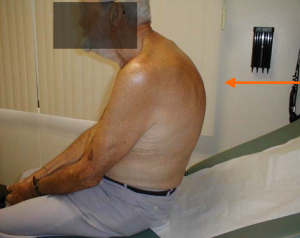Thoracic Manual Techniques and Exercises: Difference between revisions
No edit summary |
No edit summary |
||
| Line 25: | Line 25: | ||
* The ability for the patient to incorporate self-mobilizations of the thoracic spine into therapeutic exercise programs may help maximize intervention outcomes.<ref>Johnson KD, Grindstaff TL. [https://www.ncbi.nlm.nih.gov/pmc/articles/PMC3325630/ Thoracic region self-mobilization: a clinical suggestion.] International journal of sports physical therapy. 2012 Apr;7(2):252.Available from:https://www.ncbi.nlm.nih.gov/pmc/articles/PMC3325630/ (last accessed 16.4.2020)</ref> | * The ability for the patient to incorporate self-mobilizations of the thoracic spine into therapeutic exercise programs may help maximize intervention outcomes.<ref>Johnson KD, Grindstaff TL. [https://www.ncbi.nlm.nih.gov/pmc/articles/PMC3325630/ Thoracic region self-mobilization: a clinical suggestion.] International journal of sports physical therapy. 2012 Apr;7(2):252.Available from:https://www.ncbi.nlm.nih.gov/pmc/articles/PMC3325630/ (last accessed 16.4.2020)</ref> | ||
== Sub Heading 2 == | == Sub Heading 2 == | ||
{{#ev:youtube|ZMThXJf6mrE|300}}<ref>Upper thoracic functional mobilization. Available from: https://www.youtube.com/watch?v=ZMThXJf6mrE</ref>{{#ev:youtube|A8juGfCJOcc|300}}<ref>Thoracic Spine mobilization. Reverse Nag. Mulligan Mobilization with movement Technique MWM. Available from: https://www.youtube.com/watch?v=A8juGfCJOcc</ref>{{#ev:youtube|PpsxLSn3sQo|300}}<ref>Mid Thoracic Spine PA Manipulation. Available from: https://www.youtube.com/watch?v=PpsxLSn3sQo</ref> | This first 2 minute video shows a good upper thoracic function mobilisation for extension, and extension combined with rotation.{{#ev:youtube|ZMThXJf6mrE|300}}<ref>Upper thoracic functional mobilization. Available from: https://www.youtube.com/watch?v=ZMThXJf6mrE</ref>{{#ev:youtube|A8juGfCJOcc|300}}<ref>Thoracic Spine mobilization. Reverse Nag. Mulligan Mobilization with movement Technique MWM. Available from: https://www.youtube.com/watch?v=A8juGfCJOcc</ref>{{#ev:youtube|PpsxLSn3sQo|300}}<ref>Mid Thoracic Spine PA Manipulation. Available from: https://www.youtube.com/watch?v=PpsxLSn3sQo</ref> | ||
== Sub Heading 3 == | == Sub Heading 3 == | ||
Revision as of 07:45, 16 April 2020
This article or area is currently under construction and may only be partially complete. Please come back soon to see the finished work! (16/04/2020)
Original Editor - Your name will be added here if you created the original content for this page.
Top Contributors - Lucinda hampton, Jonathan Wong, Kim Jackson and Khloud Shreif
Introduction[edit | edit source]
Physiotherapists often address movement disorders of the thoracic spine that respond well to manual techniques and/or exercise prescription to address joint restrictions or muscle weakness.
This page outlines some of the Manual Techniques and Exercises for the Thoracic Spine.
Range of motion (ROM) in the thoracic region is necessary for a number of daily activities and sporting tasks such as golf, throwing sports, tennis, and rowing. Dysfunction of the thoracic spine can also play a role in breathing difficulties and may be linked to postural issues in the later stages of life. Additionally getting more ROM through the thoracic spine has impact on areas upstream and downstream the body.
- Restrictions in motion have the potential to impact performance and may manifest as local or distant musculoskeletal pathology.
- Movement of the thoracic spine is coupled with movement of the adjoining ribs. Thoracic extension involves concurrent posterior rotation (external torsion) and depression of the posterior ribs with elevation of the anterior ribs. Bending to the side is a combination of spinal segments side bending, ribs on the same come together while ribs on the opposite side separate. Inability to move well in all directions predisposes people to injury and pain.[1]
- Motion restrictions may be due to contractile or non-contractile structures, and interventions to address each specific tissue restriction can vary depending on the source of the involved tissue.
- Contractile restrictions - eg.muscle tightness, trigger points, may be addressed via muscle stretching or manual interventions such as soft-tissue mobilization or sustained pressure.
- Non-contractile restrictions - eg hypermobile, or hypomobile joints
Joint hypermobility is usually addressed with therapeutic exercise to improve neuromuscular control
Joint hypomobility may be addressed with manual interventions including joint mobilization and manipulation. Hypomobility of vertebral and costovertebral joints in the thoracic spine may prevent the patient from attaining full motion of the thorax.
- Most interventions to address thoracic spine mobility are dependent on the clinician providing the intervention.
- The ability for the patient to incorporate self-mobilizations of the thoracic spine into therapeutic exercise programs may help maximize intervention outcomes.[2]
Sub Heading 2[edit | edit source]
This first 2 minute video shows a good upper thoracic function mobilisation for extension, and extension combined with rotation.
Sub Heading 3[edit | edit source]
Resources[edit | edit source]
- bulleted list
- x
or
- numbered list
- x
References[edit | edit source]
- ↑ Lifecare North sports Clinic Thoracic spine Available from: https://www.lifecare.com.au/clinic/northern-sports-physiotherapy-clinic/news/thoracic-spine/ (last accessed 16.4.2020)
- ↑ Johnson KD, Grindstaff TL. Thoracic region self-mobilization: a clinical suggestion. International journal of sports physical therapy. 2012 Apr;7(2):252.Available from:https://www.ncbi.nlm.nih.gov/pmc/articles/PMC3325630/ (last accessed 16.4.2020)
- ↑ Upper thoracic functional mobilization. Available from: https://www.youtube.com/watch?v=ZMThXJf6mrE
- ↑ Thoracic Spine mobilization. Reverse Nag. Mulligan Mobilization with movement Technique MWM. Available from: https://www.youtube.com/watch?v=A8juGfCJOcc
- ↑ Mid Thoracic Spine PA Manipulation. Available from: https://www.youtube.com/watch?v=PpsxLSn3sQo







